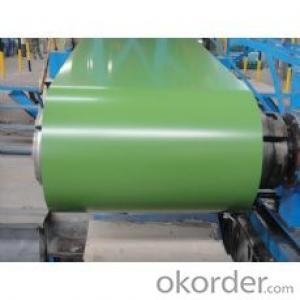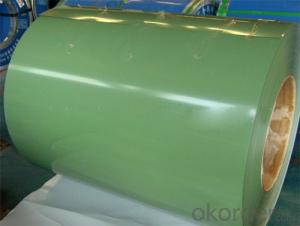Pre-Painted Galvanized Steel Sheet/Coil with Prime Quality Green Color
- Loading Port:
- Shanghai
- Payment Terms:
- TT OR LC
- Min Order Qty:
- 200 m.t.
- Supply Capability:
- 20000 m.t./month
OKorder Service Pledge
OKorder Financial Service
You Might Also Like
1. Pre-Painted Galvanized/Aluzinc Steel Coil Description:
With GI as base material, after pretreatment (degrease and chemical treatment ) and liquid dope with several layers of color, then after firing and cooling, finally the plate steel is called pre-painted galvanized (aluzinc) steel. Pre-painted galvanized steel is good capable of decoration, molding, corrosion resistance. It generally displays superior workability, durability and weather resistance.
2.Main Features of the Pre-Painted Galvanized/Aluzinc Steel Coil:
• Excellent process capability
• Smooth and flat surface
• Workability, durability
• Excellent heat resistance performance
• High strength
• Good formability
• Good visual effect
3.Pre-Painted Galvanized/Aluzinc Steel Coil Images

4.Pre-Painted Galvanized/Aluzinc Steel Coil Specification
Standard: AISI, ASTM, BS, DIN, GB, JIS
Grade: DX51D, DX52D
Thickness: 0.17-2.0mm
Brand Name: KMRLON
Model Number: coil
Type: Steel Coil
Technique: Cold Rolled
Surface Treatment: Coated
Application: Boiler Plate
Special Use: High-strength Steel Plate
Width: 20-1250mm
Length: customized
commoidty: pre-painted galvanized steel coil
Thickness: 0.13-4.0mm
width: 20-1250mm
zinc coating: 40-180g/m2
printing thickness: top side: 20+/-5 microns, back side: 5-7 microns
color: all RAL color
surface treatment: color coated
coil weight: 4-7 tons
coil ID: 508/610mm
packaging: standard seaworthy packing
5.FAQ of Pre-Painted Galvanized/Aluzinc Steel Coil
1. What’s the application of this product?
Roof, roof structure, surface sheet of balcony, frame of window, etc.
2. What’s the brand of the paint?
We use the best brand of all of the word—AKZO.
3. How about your company?
A world class manufacturer & supplier of castings forging in carbon steel and alloy steel,is one of the large-scale professional investment casting production bases in China,consisting of both casting foundry forging and machining factory. Annually more than 8000 tons Precision casting and forging parts are exported to markets in Europe,America and Japan. OEM casting and forging service available according to customer’s requirements.
4. How to guarantee the quality of the products?
We have established the international advanced quality management system,every link from raw material to final product we have strict quality test;We resolutely put an end to unqualified products flowing into the market. At the same time, we will provide necessary follow-up service assurance.
5. How long can we receive the product after purchase?
Usually within thirty working days after receiving buyer’s advance payment or LC. We will arrange the factory manufacturing as soon as possible. The cargo readiness usually takes 15-25 days, but the shipment will depend on the vessel situation.
- Q: What are the dimensions of a steel coil?
- The dimensions of a steel coil can vary depending on its intended purpose and specifications. However, typical dimensions can range from 0.15mm to 10mm in thickness, and from 600mm to 2,000mm in width. The length of a steel coil can vary as well, typically ranging from 1,500mm to 6,000mm.
- Q: What are the different types of steel coil slitting methods?
- There are three main types of steel coil slitting methods: rotary slitting, loop slitting, and pull-through slitting. Rotary slitting involves using circular knives to cut the coil into narrower strips. Loop slitting involves passing the coil through a loop that is formed between two sets of knives, which then cuts the coil into multiple strips. Pull-through slitting involves pulling the coil through an adjustable slitting head, where the knives cut the coil into desired widths.
- Q: How are steel coils used in the production of HVAC systems?
- Steel coils are used in the production of HVAC systems as they serve as the primary component for heat transfer. These coils are responsible for absorbing heat from the surrounding air and transferring it to cool the interior of a building. Additionally, steel coils are used for the condenser coils in HVAC systems, where they aid in the removal of heat from the refrigerant, allowing for efficient cooling and dehumidification.
- Q: What are the common surface treatments for steel coils?
- The common surface treatments for steel coils include galvanization, which involves coating the steel with a layer of zinc to protect against corrosion, as well as painting or powder coating to provide additional protection and enhance aesthetics.
- Q: I am looking at website on google based on the terms structural steel fabrication and simply steel fabricationI know that there must be a difference between the two terms, but it seems that many website authors use the two terms interchangeably.Do you know the key differences between the two terms?
- Steel fabrication can include any kind of manufacture of steel. Structural steel is a narrow subset which would include, for example, I-beams and would not usually include stainless steel, sheet steel, rolled steel, etc.
- Q: LIke a steel building conversion into a residental building??? Thanks.
- Right here. Steel Homes, Steel House, Steel Buildings, Steel Home Plans, ... Steel Homes, Steel House, Steel Buildings, Steel Home Plans, Steel Houses, ... Steel Homes and Buildings · Steel Office Buildings and Construction sites ... www.karmod.eu/steel-structures - 18k - Similar pages www.karmod.eu/steel-structures steel buildings metal buildings modular homes steel building ... ... log homes photographs, log homes construction, sales agents, log homes financing, ... Easy online pricing
- Q: I have heard of Cold Rolled steel, Castle Forged steel and Valerian steel and i was just wondering the difference between them.I know Valerian steel is by far the strongest and durable but what about the other two types? Do you know because i haven't read all the books yet.
- Castle Forged Steel
- Q: Moravia’s coal and steel industries face challenges because they _____. a.do not run efficientlyb.have run out of resourcesc.have a declining work forced.have not privatized
- As someone who have lived in northern Moravia at industrial steel and coal city of Ostrava, the closest point is b), but it is questionable. I am not sure how to compare efficiency of largest steel mill in Czech Republic in comparison to China which is the biggest exporter, but Czech steel factories were modernized and run more efficient that 25-35 years ago, and been privatized and owned by Mittal. The workforce had been shrinking, so not exactly sure what that c is pointing to (aging of workforce, size of it, or quality). Northern Moravia is a part of larger coal basin that extend to Poland with large coal deposits. This was foundation for the steel industry in the 1800's together with large ore deposits that was mined in proximity of the Beskidy mountains less than 25 miles from Ostrava. The iron ore mines had been depleted for several decades, and since the late 70's when communists run the country, they were already importing Soviet iron ore. Coal mining within city of Ostrava cased to exist in the 1990's due environmental issues, and also cost. The mines were getting deeper and more costly to operate and there is no more mining within Ostrava. Couple mines are still in operation in Karvina county which is next to Ostrava. Currently the coal deposits south of the city were not opened due environmental issue which would mean destruction of third largest mountain range in the country. Therefore, my conclusion is is b, as the ore and coal resources been shrinking. The biggest challenge not mentioned here is of course competition from Russia, Ukraine, and China, which can produce steel much cheaper.
- Q: Can steel coils be stacked on top of each other?
- Yes, steel coils can be stacked on top of each other.
- Q: Can steel coils be used in the production of furniture?
- Furniture production can incorporate steel coils, which offer strength, durability, and stability. This raw material is commonly utilized in manufacturing different types of furniture like chairs, tables, and bed frames. Steel coils enable heavy-duty usage by providing the necessary resilience. Furthermore, their adaptability allows for various designs and sizes, granting versatility in furniture production. Transforming the coils into components such as frames or support structures establishes a solid foundation. Additionally, the use of steel coils in furniture production enhances aesthetics as they can be finished in diverse colors and coatings to match the desired style. Overall, steel coils are a prevalent and pragmatic choice for furniture manufacturers due to their strength, durability, and design potential.
Send your message to us
Pre-Painted Galvanized Steel Sheet/Coil with Prime Quality Green Color
- Loading Port:
- Shanghai
- Payment Terms:
- TT OR LC
- Min Order Qty:
- 200 m.t.
- Supply Capability:
- 20000 m.t./month
OKorder Service Pledge
OKorder Financial Service
Similar products
Hot products
Hot Searches
Related keywords



























